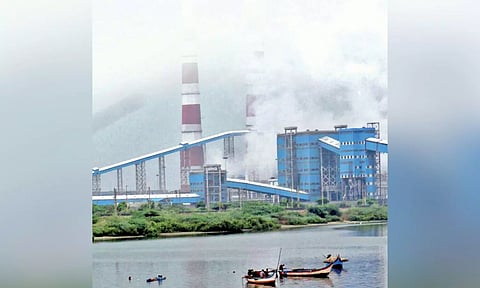

CHENNAI: A report titled ‘Tamil Nadu’s Greenhouse Gas Inventory and Pathways for Net-Zero Transition’, which is prepared by the State government along with the Council on Energy, Environment and Water (CEEW), has revealed that the State saw a 75% increase in greenhouse gas emissions (GHG) from its energy sector between 2005 and 2019.
“This corresponds to a 3.7% growth in GHG emissions compounded annually. At a cumulative value of 141 million tonnes of carbon dioxide (CO2) equivalent, the energy sector is the largest driver of emissions in the State,” the report said.
However, the share of the energy sector in overall emissions has come down by 5% during the period.
The report was released by ministers Udhayanidhi Stalin and Siva V Meyyanathan during the 2-day TN Climate Summit 2.0 that was inaugurated in Chennai, on Wednesday. Most of the electricity produced is consumed by industry, followed by domestic uses, the report said.
In the financial year 2019-2020, 42% of all power sold in the State was consumed by industry, with domestic consumers accounting for 28%. With increased industrialisation and economic prosperity, the electricity demand in the State is expected to climb further in the short to medium term.
On the other hand, the report highlighted that the State needed nearly 475GW of solar and 95GW of wind power (including off-shore) to achieve net-zero emissions by 2070. Tamil Nadu is required to add around 9GW of solar capacity and 2GW of wind capacity on average every year.
With the Union government initiating studies to establish offshore wind turbines along the TN coast, the report highlights that the State should add 17GW of offshore wind capacity to attain net-zero state by 2070. “While the country does not have offshore wind power plants currently, the National Institute of Wind Energy identified that there is potential to harness about 70GW from offshore wind, spread across 16 offshore zones along the coasts of TN and Gujarat,” it added.
As of 2022, installed generation capacity in TN was 36.9GW, of which 47% is renewable energy, 6% is hydro and 43% is thermal energy. Nuclear energy contributes to 4% of the State’s capacity. Of the total renewable energy, 84% is from wind energy.
While the emissions from energy have increased by 75%, the overall emissions from all the sectors have increased by 84% in the state with 4.45% increase annually.
Tamil Nadu accounts for around 7% of the total emissions in the country.
Meanwhile, GHG emissions from the transport sector almost tripled between 2005 and 2019 from 10 million tonnes of CO2 equivalent to 27 million tonnes of CO2 equivalent. Of the 19.7 lakh vehicles registered in TN, 87.7% ran on petrol, followed by 10% on diesel. Electric vehicles (EV) contributed only 0.17% of the vehicles, with hybrid and CNG vehicles accounting for roughly 0.5%.
“However, new EV registrations have seen a massive spike in recent years, with 26 times more EVs having been registered last year than in 2019. This increased the share of new EV registrations to 5% and reduced the shares of petrol and diesel vehicle registrations to 77% and 8.8% respectively in 2023,” the report pointed out.
On the other hand, GHG emissions from waste (wastewater and solid waste) accounted for 5% of the total emissions in 2019 as compared to 4% at the national level in 2018. Of the total emissions from waste, wastewater treatment and discharge released 85% GHG.
Speaking about the inventory, Supriya Sahu, Secretary, environment and climate change, averred: “The purpose of the inventory was to visualise the present scenarios and act on them quickly.”
'Green Tamil Nadu Mission can sequester GHG'
CHENNAI: The report also pointed out that Green Tamil Nadu (GTN) Mission is capable of sequestering emissions to 19-25 million tonnes of CO2 equivalent per year. The average annual carbon sequestration potential is 19 million tonnes of CO2 equivalent for a tree rotational period of 15 years. This goes up to 25 million tonnes of CO2 equivalent for a rotational period of 10 years. This is because during the initial period after plantation, trees sequester carbon at a much faster rate. This rate declines as the trees mature. On the other hand, carbon sequestration by land has dropped in recent years. Between 2015 and 2016, emissions from the Agriculture, Forestry and Other Land Use (AFOLU) sector have increased 4 times due to the reduction in forest areas. However, due to the decline in bovine population, especially indigenous cattle and buffalo, emissions from livestock have reduced by 1.5% annually.